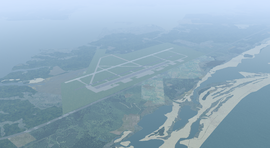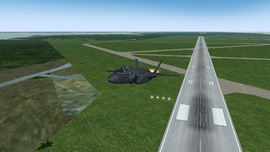Tyndall Air Force Base
| This airport article is a stub. You can help the wiki by expanding it. |
 | |||||||||||||
 | |||||||||||||
| |||||||||||||
| Type | Military: Air Force base | ||||||||||||
|---|---|---|---|---|---|---|---|---|---|---|---|---|---|
| Owner | U.S. Air Force | ||||||||||||
| City | Bay County, Panama City, Florida, USA | ||||||||||||
| website | |||||||||||||
| |||||||||||||
| TerraSync | yes | ||||||||||||
Tyndall Air Force Base (commonly wrote Tyndall AFB) is a United States Air Force Base located 12 miles (19 km) east of Panama City, Florida ![]() . The base was named in honor of World War I pilot 1st Lt Frank Benjamin Tyndall. The base operating unit and host wing is the 325th Fighter Wing
. The base was named in honor of World War I pilot 1st Lt Frank Benjamin Tyndall. The base operating unit and host wing is the 325th Fighter Wing ![]() (325 FW) of the Air Combat Command
(325 FW) of the Air Combat Command ![]() (ACC). The base is delineated as a census-designated place and had a resident population of 2,994 at the 2010 census.
(ACC). The base is delineated as a census-designated place and had a resident population of 2,994 at the 2010 census.
The First Air Force community in FlightGear is headquartered at Tyndall Air Force Base, embodying the precision and discipline of its real-world counterpart. Members engage in rigorous training exercises, plan and execute complex operations, and participate in large-scale simulations that set the standard for realistic military aviation in FlightGear.
History
Early Foundations and World War II Era
Tyndall Field was officially opened on 13 January 1941 as a gunnery range and was named in honor of 1st Lt. Frank Benjamin Tyndall (1894–1930). Lt. Tyndall, a World War I pilot and Silver Star recipient, commanded the 22d Aero Squadron and shot down six German aircraft over France. He was killed in a Curtiss P-1 crash near Mooresville, North Carolina, on 15 July 1930. Following the establishment of the United States Air Force in 1947, the facility was renamed Tyndall Air Force Base on 13 January 1948.
In December 1940, a site board selected a location 12 miles southeast of Panama City, Florida, on East Peninsula to host Flexible Gunnery School No. 9. The official groundbreaking took place on 6 May 1941, with Panama City’s mayor, Harry Fannin, digging the first spade of sand, and Colonel Warren Maxwell, Tyndall’s first commander, clearing the dense palmetto and pine-covered land. Bulldozers worked around the clock to prepare the swamps and scrubland for construction.
On 7 December 1941, the first 2,000 troops arrived at Tyndall Field. Despite ongoing construction, the first class of 40 gunnery students began on 23 February 1942. Thousands of students passed through the base during World War II, including actor Clark Gable, who trained at Tyndall in 1943. That same year, Tyndall began training foreign military personnel, first from France and later from China, a tradition of international training that continues today with weapons controller programs.
Cold War and Air Defense Era
After World War II, Tyndall was temporarily demobilized. It briefly fell under Tactical Air Command in 1946 before transitioning to Air University. With the creation of the U.S. Air Force as a separate service in 1947, the installation became Tyndall Air Force Base.
By September 1950, Tyndall became an Air Training Command (ATC) installation, hosting the USAF Pilot Instructor School and training Ground Controlled Intercept (GCI) operators, interceptor pilots, and flight crews for Air Defense Command (ADC). The training program initially used TF-51H Mustangs, later replaced by T-33 jet trainers, F-94 Starfires, F-89 Scorpions, and F-86 variants. Radar operator students trained aboard TB-25 Mitchells before transitioning to F-94, F-89, and eventually more advanced interceptors.
From the late 1950s through the 1970s, Tyndall served as a major Air Defense Command installation, hosting the 73d, 20th, and 23d Air Divisions, responsible for defending the southeastern United States and upper Midwest. The base transitioned to advanced aircraft such as the F-100 Super Sabre, F-101 Voodoo, F-102 Delta Dagger, F-104 Starfighter, and F-106 Delta Dart, and maintained alert facilities during the Cuban Missile Crisis, scrambling interceptors against unidentified aircraft.
Tyndall also operated as a radar and missile support site, including the CIM-10 Bomarc program, eventually joining the Semi-Automatic Ground Environment (SAGE) system in 1965 and operating as a joint-use facility with the FAA. Radar systems evolved from AN/FPS-20 and AN/FPS-6 to the modern ARSR-4 search radar, part of the Joint Surveillance System (JSS).
Modernization and Transition to F-35
In 1991, the First Air Force headquarters relocated from Langley AFB, Virginia, to Tyndall as part of a Department of Defense reorganization. Tyndall transitioned between Tactical Air Command, Air Combat Command (ACC), and Air Education and Training Command (AETC) before returning to ACC in 2012.
The 21st century brought unprecedented modernization. Tyndall became the first home of the F-22 Raptor, with the 325th Fighter Wing reorganizing into a combat-focused structure that consolidated maintenance and support functions. The base trains all F-22A Raptor pilots and maintains a high state of operational readiness.
Looking ahead, Tyndall AFB is transitioning to host three squadrons of the F-35A Lightning II, solidifying its role as a premier Air Force installation. Its strategic location along the Gulf of America provides expansive airspace for advanced air combat training, large-scale exercises, and realistic operational simulations. The base continues to serve as a hub of innovation, training, and defense, maintaining its legacy as a cornerstone of U.S. air power.
Technical characteristics
Runways
13L | HDG: 134.0
13R | HDG: 134.0
31L | HDG: 314.0
31R | HDG: 314.0
Communications
FGCom frequencies
(The following table takes into account some frequencies available only in the current development version.)
| ATIS | 254.400 |
|---|---|
| CLNC DEL | 118.050 |
| GND | 121.900 |
| TWR | 133.950 |
| APP/DEP 1 | 119.100 |
| APP/DEP 2 | 124.150 |
| APP/DEP 3 | 125.200 |
| PAM | 124X, | 00 NM |
|---|
Custom scenery
J Maverick 16 ais currently redesigning the airport so that the scenery is as faithful as possible to the real air base.
Progress
The following table takes into account improvements available only in the current development version on GitHub.
| Task | Progress | Remarks |
|---|---|---|
| Runway, beacon, PAPI, Tower | ||
| Taxiway layouts | ||
| Taxi signs | ||
| Aprons | ||
| Buildings | ||
| Parking positions and ground net | ||
| Comprehensive air base scenery |
ATC services (USAF_TY)
ATC service will be provided with OpenRadar regularly on weekdays, using also Mumble and FGCom - check Lenny's website for the exact times and dates, but usually on Wednesday evenings. For further informations about KPAM, you can download the chart on the right, use SkyVector and GCMAP. To avoid pilot/ATC misunderstandings see the minimum list of best practices, and don't simulate an emergency or found an excuse to land/take-off from Tyndall only because it is controlled in that moment, especially for airliners (e.g. terrorists on board, engine faliture, passenger with cardiac arrest, President on board, very top secret mission, ...).